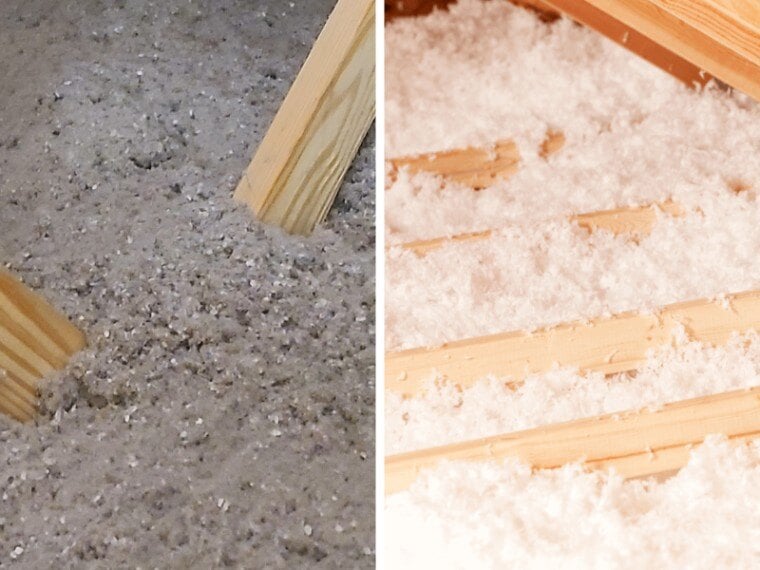Which Blown-In Insulation Is Best For Attics?
September 4th, 2024
3 min read

Your attic needs new insulation, and you’re planning on using blown-in. But which blown-in product should you use? Is there a type of blown-in insulation that is better for attics?
South Central Services has insulated hundreds of homes in and around Greencastle, Pennsylvania. Our insulation team installs both spray foam and blown-in cellulose in attics. While blown-in insulations are similar in many ways, a stand-out feature makes one better than the other.
By the end of this article, you will understand:
- What types of blown-in insulation are available for attics
- What blown-in insulations have in common
- How blown-in insulations differ by material
- Which blown-in insulation is best for your attic
Don't have time to read right now? Check out everything you need to know at a glance.
There Are Two Types Of Commonly Used Blown-In Insulation.
Blown-in insulation is an umbrella term for loose-fill insulation blown onto an attic floor. If more details aren’t given, blown-in insulation could refer to either fiberglass or cellulose. When choosing the best blown-in insulation for an attic, the options are blown-in cellulose and blown-in fiberglass.

There is another type of blown-in insulation called blown-in dense pack. For the purposes of this article, we will not be exploring dense pack insulation for ceilings and walls. This article will only compare the performance and cost of cellulose and fiberglass for the attic floor.
Blown-In Insulations Have Comparable Performance.
Comparing spray foam insulation to another product shows dramatic differences. Spray foam offers more features and performance than many insulations. When comparing one blown-in product to another, are there similar dramatic differences?
Blown-in cellulose and blown-in fiberglass offer comparable performance. Neither product delivers a unique feature that the other cannot provide. Both products settle over time and can reach R-values between R-19 and R-60. Both are composed of recycled materials. When it comes to your attic floor, you won’t see a significant difference between the two.
Even the pricing of these two insulations fluctuates. At certain times, cellulose may be cheaper than fiberglass. Maintaining an R-value of R-49 generally costs between $2.50 and $4.00 per square foot for either insulation.
With Comparable Performance, Why Choose Blown-In Cellulose?
At South Central Services, we only install blown-in Nu-Wool cellulose. If blown-in fiberglass offers comparable performance, why wouldn’t we offer both insulations?
Although the costs of these two products fluctuate, we have committed to blown-in cellulose. Our team has a rig dedicated to installing cellulose. Additionally, we prefer cellulose for safety reasons.
Blown-in fiberglass is not inherently unsafe. However, it is composed of fine glass and plastic fibers. These fibers can become embedded in your lungs or skin without appropriate PPE.

Ideally, you will not disturb your blown-in attic insulation. Blown-in insulation lasts longer when it is not disturbed. Interacting with blown-in insulation will cause it to settle faster, meaning it will need to be topped off sooner to maintain R-value.
Sometimes, however, blown-in insulation ends up being disturbed. From this perspective, blown-in cellulose is better than blown-in fiberglass. Since fiberglass is made up of tiny glass and plastic fibers, it runs the risk of contact dermatitis. Always wear gloves and a mask when interacting with fiberglass insulation.
Blown-in cellulose can be a dusty product, but it will not harm you if you touch it without gloves. Additionally, any airborne particles from touching the cellulose would only be dust.
Airborne particles from touching loose-fill fiberglass are made of glass, which would be dangerous to ingest.
Both Types Of Blown-In Benefit From An Airtight Seal.
Whether you choose cellulose or fiberglass, both types of blown-in are limited in their insulating abilities.
Heat travels through conduction, convection, and radiation. Blown-in insulation can only combat one of the three.
.jpg?width=300&height=400&name=7.30.24%20Blown-in%20prep%20(T).jpg) The traditional measure of insulating power is R-value, or resistance value. R-value tells you how well a material can resist conductive heat transfer. Both blown-in cellulose and blown-in fiberglass have the necessary R-value to slow conductive heat transfer. But what about convection and radiation?
The traditional measure of insulating power is R-value, or resistance value. R-value tells you how well a material can resist conductive heat transfer. Both blown-in cellulose and blown-in fiberglass have the necessary R-value to slow conductive heat transfer. But what about convection and radiation?
We recommend putting an airtight seal on your attic floor before installing blown-in insulation. An air-seal stops air leakage, which in turn slows convective and radiant heat. While adding an air-seal will increase the cost of blown-in for your attic, it will also maximize its performance for your home. Neither insulation can perform at its best without air-sealing.
The Bottom Line About Which Blown-In Is Best For Attics
When it comes to costs and R-value, both blown-in fiberglass and cellulose are rather comparable. While the two products are made of different materials, they deliver very similar functionality as attic insulation.
No matter which type of blown-in you choose, we always recommend air-sealing the attic floor first to boost the insulation performance. When working with South Central Services for blown-in in the attic, you will receive an airtight seal in your attic floor and an even layer of blown-in cellulose.
Now that you’ve compared blown-in cellulose and blown-in fiberglass in attic applications, your next step is to:
- Discover if you can prevent blown-in insulation from settling
- Estimate the cost of blown-in insulation for your attic floor
- Weigh the pros and cons of blown-in cellulose insulation
Disclaimer: While we strive to publish information accurate to building science, local building codes and standards supersede our recommendations.
Alexis has been fascinated by spray foam insulation since 2018. When she isn’t thinking about insulation, Alexis is geeking out over storytelling and spreadsheets.


